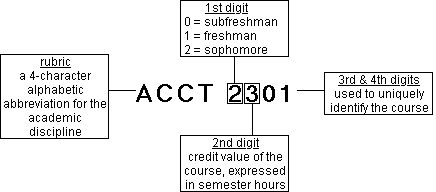Course Naming Standard
All TCCNS courses are identified by a four character course prefix representing the course type or academic discipline, followed by a four digit course number.
The first digit of the course number denotes the academic level
of the course. The second digit represents the credit value of
the course in semester hours. The third and fourth digits
establish course sequencing and/or distinguish the course from
others of the same level, credit value, and prefix.

All prefix/number combinations correspond to the course descriptions
listed in the
Academic Course Guide Manual
(ACGM), published by the
Texas Higher Education Coordinating Board.
The ACGM is the official list of courses for which state funding
is provided to community colleges; in effect, the ACGM comprises
the academic (in contrast to occupational/technical) courses
Texas public community colleges may offer without obtaining
special permission from the Coordinating Board.


